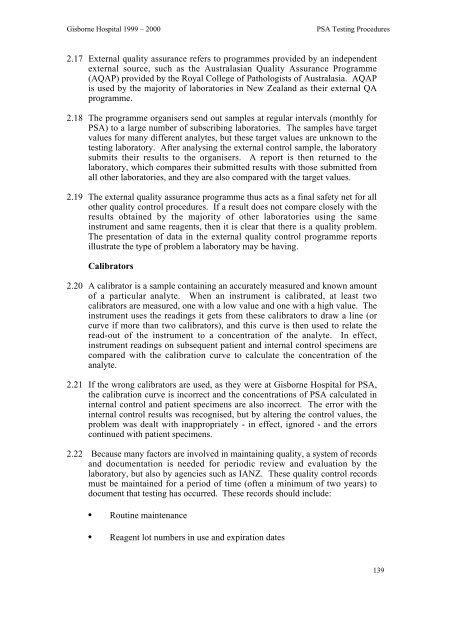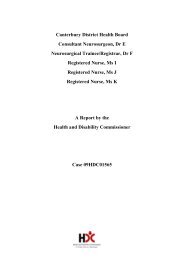Gisborne Hospital Report - Health and Disability Commissioner
Gisborne Hospital Report - Health and Disability Commissioner
Gisborne Hospital Report - Health and Disability Commissioner
You also want an ePaper? Increase the reach of your titles
YUMPU automatically turns print PDFs into web optimized ePapers that Google loves.
<strong>Gisborne</strong> <strong>Hospital</strong> 1999 – 2000<br />
PSA Testing Procedures<br />
2.17 External quality assurance refers to programmes provided by an independent<br />
external source, such as the Australasian Quality Assurance Programme<br />
(AQAP) provided by the Royal College of Pathologists of Australasia. AQAP<br />
is used by the majority of laboratories in New Zeal<strong>and</strong> as their external QA<br />
programme.<br />
2.18 The programme organisers send out samples at regular intervals (monthly for<br />
PSA) to a large number of subscribing laboratories. The samples have target<br />
values for many different analytes, but these target values are unknown to the<br />
testing laboratory. After analysing the external control sample, the laboratory<br />
submits their results to the organisers. A report is then returned to the<br />
laboratory, which compares their submitted results with those submitted from<br />
all other laboratories, <strong>and</strong> they are also compared with the target values.<br />
2.19 The external quality assurance programme thus acts as a final safety net for all<br />
other quality control procedures. If a result does not compare closely with the<br />
results obtained by the majority of other laboratories using the same<br />
instrument <strong>and</strong> same reagents, then it is clear that there is a quality problem.<br />
The presentation of data in the external quality control programme reports<br />
illustrate the type of problem a laboratory may be having.<br />
Calibrators<br />
2.20 A calibrator is a sample containing an accurately measured <strong>and</strong> known amount<br />
of a particular analyte. When an instrument is calibrated, at least two<br />
calibrators are measured, one with a low value <strong>and</strong> one with a high value. The<br />
instrument uses the readings it gets from these calibrators to draw a line (or<br />
curve if more than two calibrators), <strong>and</strong> this curve is then used to relate the<br />
read-out of the instrument to a concentration of the analyte. In effect,<br />
instrument readings on subsequent patient <strong>and</strong> internal control specimens are<br />
compared with the calibration curve to calculate the concentration of the<br />
analyte.<br />
2.21 If the wrong calibrators are used, as they were at <strong>Gisborne</strong> <strong>Hospital</strong> for PSA,<br />
the calibration curve is incorrect <strong>and</strong> the concentrations of PSA calculated in<br />
internal control <strong>and</strong> patient specimens are also incorrect. The error with the<br />
internal control results was recognised, but by altering the control values, the<br />
problem was dealt with inappropriately - in effect, ignored - <strong>and</strong> the errors<br />
continued with patient specimens.<br />
2.22 Because many factors are involved in maintaining quality, a system of records<br />
<strong>and</strong> documentation is needed for periodic review <strong>and</strong> evaluation by the<br />
laboratory, but also by agencies such as IANZ. These quality control records<br />
must be maintained for a period of time (often a minimum of two years) to<br />
document that testing has occurred. These records should include:<br />
• Routine maintenance<br />
• Reagent lot numbers in use <strong>and</strong> expiration dates<br />
139
















